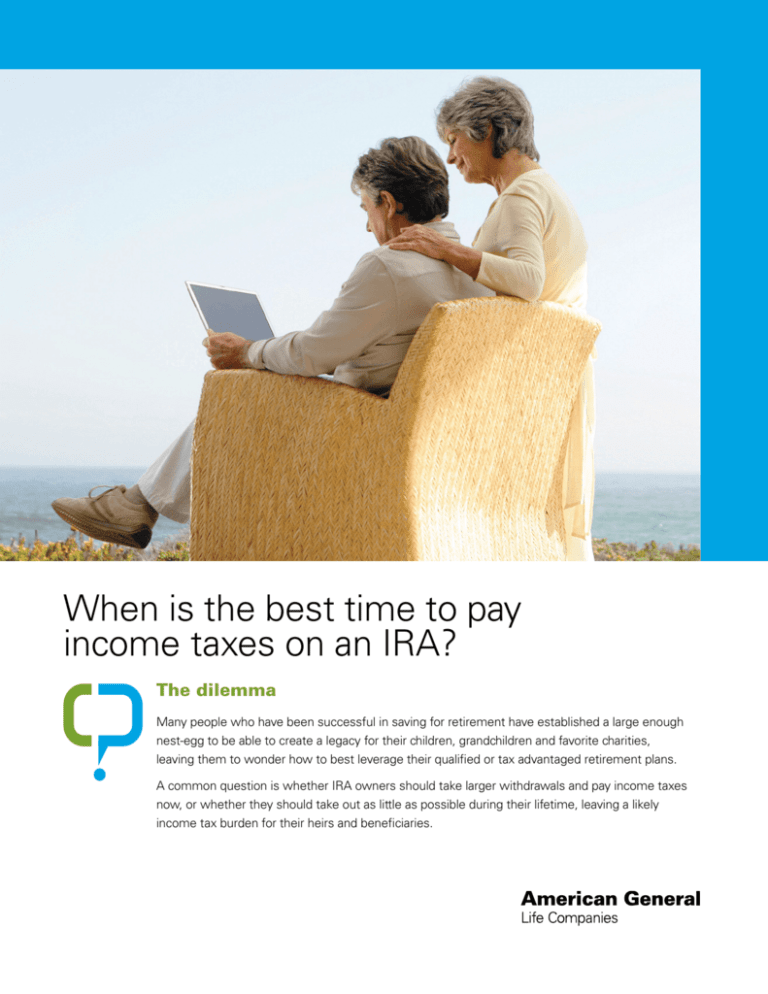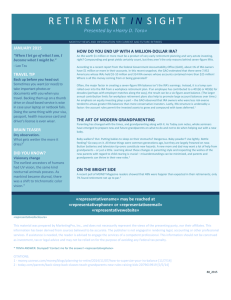
When is the best time to pay
income taxes on an IRA?
The dilemma
Many people who have been successful in saving for retirement have established a large enough
nest-egg to be able to create a legacy for their children, grandchildren and favorite charities,
leaving them to wonder how to best leverage their qualified or tax advantaged retirement plans.
A common question is whether IRA owners should take larger withdrawals and pay income taxes
now, or whether they should take out as little as possible during their lifetime, leaving a likely
income tax burden for their heirs and beneficiaries.
Tax Saving Alternatives for IRAs
If an IRA owner is looking to protect loved ones and to
maximize wealth transfer, he/she can utilize life
insurance to minimize the tax burden that inheriting an
IRA may impose on a beneficiary. With two different
strategies identified in this brochure, investors can
maximize the after-tax value of their IRA or even
eliminate taxes paid on the IRA inheritance.2
The chart below provides a comparison of what
IRA distributions look like on the same IRA account
before (“Current” bar) and after (“Tax Offset” and
“Tax Elimination” bars) the two solutions where used.
These powerful strategies can provide significant tax
savings, maximize the amount of money beneficiaries
receive from IRAs and provide greater flexibility in how
the assets are ultimately put to use.
43% of respondents to a recent
study said their ideal retirement
investments enable them to
leave money to their family,
community or charities.3
IRA Distribution Amounts
Comparison of IRA Wealth Transfer Solutions
$1,000,000
$1,000,000
900,000
800,000
700,000
600,000
500,000
$500,000
400,000
300,000
$325,000
200,000
100,000
$0
Current
Income Tax
Offset
Solution
Income Tax
Elimination
Solution
Fees and charges, if applicable, are not reflected in this example and would reduce the amount shown. Income taxes on tax-deferred accounts are payable upon withdrawal.
Federal restrictions and a 10% federal early withdrawal penalty may apply to withdrawals prior to age 59½. This information is hypothetical and only an example. It does not
reflect the return of any investment and is not a guarantee of future income.
ira required minimum distributions
Proper consideration should be given to IRA
distributions and the resulting tax implications
as these can affect the amount a beneficiary
may inherit upon IRA owner’s death.
■■
■■
Beginning at age 70½, the IRA owner is required
to withdraw an increasing percentage of an IRA’s
account value each year until the IRA is exhausted –
“Required Minimum Distribution (RMD)”.
Eventually RMDs will be larger than the expected
annual interest growth. When that happens,
the IRA may well be at its peak value, typically
between ages 85 and 90, as depicted in the
chart below.1
■■
When an IRA owner dies, the beneficiary
must include taxable amounts received in his
or her gross income.
■■
Because IRAs are frequently transferred at or near
their peak value, IRA inheritances are often taxed
at higher income tax rates.
It is not uncommon for retirees to die sometime
between their 75th and 95th birthday. As the graph
below depicts, when that happens IRAs are often
passed to the next generation at-or-near peak values.
Because these IRA inheritances are fully taxable to
the beneficiaries as ordinary income, they are often
taxed at very high rates.
Hypothetical IRA Peak Value Estimation
Due to Required Minimum Distributions
IRA Value
$160,000
140,000
120,000
100,000
80,000
60,000
40,000
IRA
Owner‘s
Age
20,000
$0
70
75
80
85
90
95
100
105
110
115
Hypothetical IRA assumes $100,000 IRA with a 7% hypothetical annual return
The chart assumes an 7% annual rate of return. Fees and charges, if applicable, are not reflected in this example and would reduce the amount shown. Income taxes
on tax-deferred accounts are payable upon withdrawal. Federal restrictions and a 10% federal early withdrawal penalty may apply to withdrawals prior to age 59½.
This information is hypothetical and only an example. It does not reflect the return of any investment and is not a guarantee of future income.
Innovative solutions for IRA wealth transfer
The two solutions described here help reduce or eliminate the taxes imposed on an IRA beneficiary, thus
maximizing the value of the inheritance.
“Current” Scenario It is not uncommon for an IRA owner to reinvest his/her mandated IRA RMDs while using other
portfolio assets for retirement and living expenses. This leaves the majority of the IRA balance intact and transferred,
along with the tax liability, to the beneficiary at the owner’s death4.
At IRA owner’s death, bulk of IRA is intact
and paid to beneficiary
■■ Income taxes are due on the IRA amounts
received by the beneficiary5
■■ If a beneficiary is in his/her 50’s and 60’s (often
the case) at IRA owner’s death, earning his/her
highest career income, he/she will pay taxes
in a high income tax rate.
■■
The addition of IRA inheritance to beneficiary’s
existing taxable income could push the recipient
into a higher tax bracket.
■■ This can result in excessive income taxes to the
beneficiary, reducing the net value of his or her
inheritance — see diagram below for an example.
■■ The constraints of maintaining the asset’s tax
deferred status may not meet the beneficiary’s
existing financial and retirement planning needs.
■■
Estimating Tax Impact of IRA Inheritance
Determine hypothetical value
of IRA when it would be
transferred to beneficiary
Estimate income tax beneficiary
would owe if inherited as a lump
sum when IRA owner dies at 80
Estimated value at age 80................................... x Estimated income tax rate.............................. = Taxes owed by beneficiary
$500,000.................................................................. x 35%...................................................................... = $175,000 reduction in IRA value
Solution 1 Offset IRA Beneficiary Income Taxes
Use IRA RMDs to help pay for a life insurance policy equal to income tax due from beneficiary at time of
inheritance. Life insurance benefit pays income tax due, full value of the IRA is maintained.
IRA Income Tax Offset Solution
Determine hypothetical value
of IRA value when it would be
transferred to beneficiary
Estimate income tax beneficiary
would owe if inherited as a lump
sum when IRA owner dies at 80
Use portion of RMD to purchase
life insurance equal to beneficiary’s
estimated taxes at time of inheritance
Estimated value at age 80........................................... x Estimated income tax rate..................................... = Taxes owed; purchase life insurance for this amount
$500,000.......................................................................... x 35%.............................................................................. = Beneficiary receives life insurance benefits of $175k
to pay taxes thus retaining full peak IRA value of $500k
Results: Beneficiary receives life insurance death benefits income tax-free and can use those funds to pay the
taxes due on IRA inheritance.6
■■
Now, beneficiary owns the IRA funds and all of the income taxes have been paid. Beneficiary has discretion to
invest/use full amount of IRA funds without penalty taxes or required distributions.
Solution 2 Eliminate IRA Beneficiary Income Taxes
By creatively incorporating a charity and the IRA’s RMDs to fund a life insurance policy for beneficiaries in a similar but
slightly different manner as Solution #1, the federal taxes on the distribution of an IRA can be completely eliminated.
Part 1: Name a tax-exempt charity as the IRA beneficiary. With the charity’s tax exempt status, no taxes will be due
on the inherited IRA funds. See example below:
IRA Income Tax Elimination: Charitable Bequest
Determine hypothetical value
of IRA when it would be
transferred to beneficiary
Name tax-exempt charity as
beneficiary of IRA; no income
taxes are paid on IRA proceeds
Estimated value at age 80................................... Charitable beneficiary is tax exempt
$500,000.................................................................. $500,000 net IRA proceeds tax-free
Part 2: This solution can be taken a step further to incorporate a loved one as a beneficiary.
Use IRA RMDs to help pay for a life insurance policy equal to the estimated peak value of the IRA. Loved ones can
be named as beneficiary of the life insurance policy and would receive the life insurance death benefits income
tax-free under the current tax law 6. See example below:
IRA Income Tax Elimination: Combined Legacy
Determine hypothetical value
of IRA when it would be
transferred to beneficiary
Purchase life insurance policy
= to hypothetical value of IRA –
loved one named as beneficiary
Estimated value at age 80................................... Purchase life insurance policy for loved one
$500,000.................................................................. $500,000 policy; $0 taxes due
Results: Total wealth transferred ($1,000,000) is more than three times the amount of net after-tax IRA
inheritance in original scenario on page 2 ($325,000), and the income taxes have been eliminated.
■■
■■
■■
Beneficiary of life insurance policy receives full death benefit (equal to estimated IRA value) income tax-free6.
Charitable IRA beneficiary receives full value of IRA income tax-free (at IRA owner’s death)
Zero taxes are paid on either the IRA or the life insurance policy
Find out more
Speak to your American General Life
representative today about the many life
insurance options available for your situation.
Depends on life expectancy factors, the assumed annual rate of return and additional deposits or withdrawals made.
American General Life Insurance Company and their distributors and representatives may not give tax, accounting or legal advice. Any tax statements in this material are not
intended to suggest the avoidance of U.S. federal, state or local tax penalties. Such discussions generally are based upon the company’s understanding of current tax rules and
interpretations. Tax laws are subject to legislative modification, and while many such modifications will have only a prospective application, it is important to recognize that a
change could have retroactive effect as well. Individuals should seek the advice of an independent tax advisor or attorney for more complete information concerning their particular
circumstances and any tax statements made in this material.
3
The AIG Retirement Re-SetSM Study is a public opinion poll conducted in the United States by Harris Interactive with telephone interviews among 3,426 respondents
aged 55 or older.
4
Additional deferral may be extended based upon titling and certain beneficiary elections; however income tax liability will vest upon ultimate distribution as ordinary income.
5
Under current law, beneficiary may defer immediate taxation by electing to take required annual distributions from an inherited IRA over his/her life expectancy. Additionally,
a surviving spouse beneficiary may transfer the IRA into his/her own name and delay distribution until age 70 1/2. However the taxation portion of the IRA at date of death
will ultimately be subject to deferal income tax.
6
Life Insurance death benefits are generally tax-free for beneficiaries under IRC101(a), but may be taxable in part or whole under certain situations.
1
2
Policies issued by: American General Life Insurance Company (AGL), 2727-A Allen Parkway, Houston, Texas 77019 and The United States Life
Insurance Company in the City of New York (US Life), One World Financial Center, 200 Liberty Street, New York, New York, 10281.The underwriting
risks, financial and contractual obligations and support functions associated with the products issued by AGL and US Life are the issuing insurer’s
responsibility. Guarantees are subject to the claims-paying ability of the issuing insurance company. US Life is authorized to conduct insurance business
in New York. American General Life Companies, www.americangeneral.com, is the marketing name for a group of affiliated domestic life insurers,
including AGL and US Life.
©2013. All rights reserved.
AGLC107214






